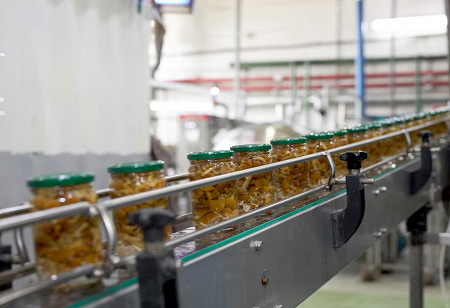
How Automation is Transforming the Food Processing Equipment Industry
Automation in food processing has changed production processes, safety, and quality even better. The demand for industrial automation is anticipated to grow by 9.3% per year and will reach USD $307.7 billion in 2030. The growing demand for food products continues to rise, and automation allows companies to fulfill consumer demands to meet consumer expectations without sacrificing quality. Automation in food processing also reduces labor, limits mistakes made by humans, and supports a more consistent quality level in food products. Food production contains some of the highest standards of quality and necessity. Automation enhances food safety by reducing human contact, creating a cleaner working environment, and using technology to monitor in real time. With all these advances in technology and automation, predictive maintenance also has an impact. Companies can reduce downtime and use their production capabilities more efficiently.
Increased Efficiency and Speed
Automation greatly improves efficiency and speed in the food sector. Automation allows industry operators to meet increased consumer demand while ensuring food product quality and safety. Automation can streamline many of the most labor-intensive and repetitive tasks associated with food preparation and production, such as ingredient mixing, portioning, cooking, packaging, and labeling. It increases the output of the production process; also by automating, it reduces the reliance on human labor, which can be uncertain and limited by exhaustion or error.
Automated systems run continuously and with accuracy, which can yield an increased amount of output for a lesser amount of time. For instance, high-speed filling and sealing machines can fill, seal, and package thousands of packages per hour, far greater than any manual process. Besides reducing processing times, automation also enhances resource efficiency. Automation reduces waste through accurate measurements of ingredients and consistency in the quality of each batch. One of the other inefficiencies that automation promotes efficiency is downtime. Smart machines can often detect equipment malfunctions, they can self-diagnose, even notifying maintenance teams before a breakdown. The ability to perform predictive maintenance mitigates nearly all unplanned interruptions which helps keep the production line continuously moving.
There are various Indian food companies like Nestlé India and Parle Products that have adapted their production lines to automate their processes to the extent that allows them to scale up their production quickly and efficiently. Automated lines are used throughout production, from the mixing of dough to final packaging, enabling the companies to supply food nationally or internationally in high volumes.
Improved Food Quality and Hygiene
The food safety and hygiene standards of the food industry have increased significantly due to automation because of the decreased amount of human involvement in the process and the cleaner, more controllable environment. Manual processes introduce the risk of contamination through humans contributing to the chances of unsanitary practices, unhygienic, and uneven practices. Automation helps mitigate these concerns with machines and sensors keeping control of food processing, packaging, and storage in the way of manufacture, packaging, and storage with measures that make things consistent.
Reducing direct contact with humans during processing is one of the most significant ways that automation can enhance hygiene. Robotic and conveyor arms or automated packaging systems reduce the chances of contaminating with someone’s unwashed hands, sneezes, or improper handling during processing. Moreover, automatic cleaning and sanitizing systems, including technologies like Clean-in-Place (CIP), will operate independently of human oversight or execution, and clean equipment at set intervals systematically to remove bacteria and allergens more effectively than cleaning and sanitizing by hand.
Companies such as Amul in India have committed to automation to ensure strict food safety and hygiene standards. Automated milk collection, testing, and processing systems allow for sanitation and quality at every level.
R.S. Sodhi, Managing Director, Amul said, “From collection of milk in the villages, or chilling them in the village, collection of milk in the road milk tanker, bringing it to the nearest chilling centre and processing it, we ensure that we follow all recommended hygienic sanitary practices as we are in the food business. The members have been educated on how they should maintain distance, wash hands, use a mask or sanitise the trucks.”
Automation permits the monitoring of important safety indicators, such as temperature, humidity, and pressure, in real-time. When a reading is outside of the safe range, the system can immediately alert staff or enact automatic correction to ensure food is always processed under safe and desirable conditions. The control aspect of automation also plays a vital role in preventing spoilage and bacterial growth. Additionally, automated systems log every step in the process, from ingredient sourcing to final packaging, which provides measures for traceability and regulatory requirements. This information allows for prompt identification of food safety issues, resulting in a quick isolation of the food safety concern.
Consistent Product Quality
In the food industry, it is important to maintain consistency in product quality to maintain customer trust and brand loyalty. Automation will allow you to achieve consistency by removing variability and increasing accuracy in the production process. Automated systems are programmed to follow specific recipes, utilize accurate ingredient measures, and restrict controls such as temperature, time, and speed. This high level of accuracy can help to ensure that each batch of food created meets its quality specifications in terms of taste, texture, and appearance. Automated machines are consistent in mixing ingredients, cutting material, and bagging and ensure the same results in every operation.
Britannia Industries is a primary example of the effective application of automation in India. A significant portion of its biscuits and baked products are produced on high-speed automated production lines. In addition, in each process, Britannia leverages automated quality controls to ensure consistency with its products while maintaining the desired quality across its product ranges.
Rajneet Kohli, chief executive officer and executive director, Britannia Industries said, “Our priority is to provide consumers with products that are safe, meet all regulatory requirements, and fulfill our quality standards.”
New technologies such as programmable logic controllers (PLCs), sensors, and vision systems allow the quality to be monitored in real-time, enabling an immediate correction to be made if a defect is determined to exist. That is, any defective items were eliminated or corrected, so that the possibility of error reduced the defective goods onto the marketplace.
Real-time monitoring and data analytics
Real-time monitoring and data analytics have emerged as powerful tools in the current food industry as a response to the constant demands for greater efficiency, safety, and quality. The evolution of automation systems with sensors and IoT devices allows for a comprehensive set of parameters such as temperature, humidity, pH levels, and performance of equipment in food production to be monitored. This constant flow of data is essential in helping maintain adequate conditions during food processing, storage, and transportation and to ensure food safety from contamination.
Organizations are able to quickly respond in real-time and notice when there are variances with their standards and make immediate adjustments if necessary. A well-designed and run real-time monitoring system allows alerts to be sent quickly if say a decrease in temperature is measured in a cold storage unit to avoid spoilage. This responsiveness means less downtime, protects businesses from loss of product, and increases operating efficiency.
By helping convert raw data into insights, data analytics further adds value. Through the study of trends and patterns over time, food companies can determine how to best optimize production schedules, identify opportunities for preventative maintenance on equipment, reduce waste, improve inventory management, and be able to forecast demand through predictive analytics, supply chain planning, and ultimately minimize overproduction or under stocking.
In an interview with ET Digital, Sanjay Singal, Chief Operating Officer, Dairy & Beverages, ITC Foods, said "Technology, including artificial intelligence (AI), can revolutionize the dairy and beverages supply chain in several ways. We are leveraging AI in our dairy and beverage manufacturing facilities to ensure product quality through tools like visual inspection systems, real-time monitoring with feedback mechanisms."
Indian food corporations such as ITC Limited and Mother Dairy are already using real-time monitoring across their businesses. The real-time monitoring systems help ensure the products were of appropriate quality and safety standards, and it also provides food business with real-time operational cost saving per better decisions.

